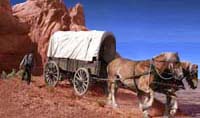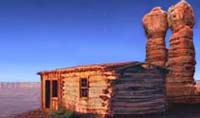 Return to Biography Selections
Return to Biography Selections |
 Download a Printable
Download a Printable
PDF File |
Roswell Stevens Jr.
Born: 17 November, 1808: Mt. Pleasant, Ontario Canadai
Died: 4 May, 1880: Bluff Utah
Married: Vallie Mariah Doyle, 1827, Canada. Divorced 1852.
Married: Mary Ann Peterson, 1854, Utah
Father: Jesse N. Smith
Mother: Emma Seraphine
Early Life and Conversion
Roswell Stevens Jr. was the third child born to Roswell and Sybel Spencer Stevens. Roswell’s ancestors have been traced to Yorkshire, England and include Puritans and early American settlers. After the American Revolution, Roswell and Sybel Stevens immigrated to Ontario, Canada, where young Roswell Jr. was born and raised. Little is known about Roswell’s early life, as he left behind no written recollections of his own. Eventually, while still in Mt. Pleasant, Ontario, Roswell married Vallie Mariah Doyle, and the two settled down to farm, eventually having four children.
In the fall of 1833 Joseph Smith and Sidney Rigdon preached to the Mt. Pleasant community, where Roswell and his family first heard the gospel. In December of 1833 Roswell’s sister, Sarah, was baptized, and in the spring of 1834 Roswell and his family joined the LDS church as well. In 1835 Roswell sold his farm and brought his family, along with his sister Sarah, to Missouri. After settling initially in Caldwell County near Far West, Roswell moved farther north to Daviess County. Soon after, Roswell’s parents joined them in Missouri. When the bulk of the Latter-Day Saints moved from Missouri to Nauvoo, Roswell Stevens Jr. and his family went with them. Roswell served as a police officer in Nauvoo and aided in the construction of many public and private buildings. Although little is known about the Stevens family’s activities in Nauvoo, they were some of the first church members to receive their endowment in the Nauvoo Temple. Eventually Roswell became a “right-hand man” to Brigham Young and was given responsibility to gather boats and ferries to assist the saints in crossing the Mississippi. Roswell also served as a bodyguard for prominent church leaders during the exodus from Nauvoo.ii
Mormon Battalion Member
Roswell Stevens Jr. was one the men who enlisted in the Mormon Battalion shortly after leaving Nauvoo en route to the West. Roswell was appointed 4th Corporal in Company E, where many of his trademark pioneer skills would be refined. Roswell accompanied the group to Ft. Leavenworth, where he sent his meager clothing allowance back to Council Bluffs to aid his family. Despite a debilitating sickness, Roswell stayed with the Battalion until they reached Santé Fe, where he was chosen to take $4,000 of Battalion wages back to Brigham Young and the rest of the Saints. For most of the return trip Roswell acted as John D. Lees bodyguard. This trek proved providential as it quickly boosted Roswell’s health, in preparation for future travels.iii
Emigration and Utah Settlement
Upon his return to Council Bluffs in 1857, Roswell was selected by Brigham Young to accompany the first wagon train to leave for the Salt Lake Valley. In addition to being an outstanding carpenter, Roswell was good with a rifle and was subsequently chosen to provide game meat for the company. When the wagon train reached Ft. Laramie, Brigham Young assigned Roswell to go with three others to Colorado and guide another group of saints to the valley. This group eventually joined the first company in the Salt Lake Valley five days after Brigham Young and the original party arrived. The following August, Roswell returned to Winter Quarters with Brigham Young and was given stewardship over the families of the Mormon Battalion members.iv
In 1850 Roswell brought his own family to Utah and settled in Mountainville, now called Alpine, south of Salt Lake City. Here Roswell was a counselor in a branch presidency and had an active role in building the local meetinghouse and school. In 1851 Roswell returned again to Winter Quarters to captain one of the last wagon trains of Nauvoo refugees. In 1853, after Roswell returned to his home in Mountainville, his wife Mariah divorced him. She promptly remarried and moved to Idaho. One year later Roswell married Mary Ann Peterson, the daughter of Charles Peterson, another valiant colonizer and faithful Latter-Day Saint. Together Charles and Roswell helped build a road into the Weber Valley and eventually settled in what is now Morgan Utah. Roswell and Mary Ann’s first two children were the first white children born in that area.v
Roswell and Mary Ann’s life in the Weber Valley was rugged but good. They coexisted peacefully with the local Indians and were primarily self-sufficient. Often, the family would awaken on winter mornings to “find an Indian asleep on the rug in front of their fireplace having quietly opened the door during the night and [crept] in where it was warm”. Here Roswell and his family lived in isolation: they often went without bread because it was too expensive to have it brought to them. Eventually, Roswell and his family homesteaded a tract of land across the valley, now called Enterprise, and operated a successful sawmill.vi
In 1865, at the request of Brigham Young, Roswell moved to Echo Canyon to assist in the building of the railroad. While there, the Stevens family lived in caves and dugouts after their initial hut was torn down to provide lumber for a telegraph pole. In 1872 Roswell sold his Echo property and moved to Upton, Utah. While living in Upton, a diphtheria epidemic broke out and many children fell ill to the disease. Roswell, at this time an experienced carpenter, made many of the children’s’ coffins while Mary Ann added the cloth, lace and padding.vii
Hole-In-The-Rock Pioneer
In 1879 Roswell sold his property and joined a group of pioneers who were leaving to fulfill a request made by Brigham Young at the time of his death. His two nephews, Walter Joshua and David Alma Stevens, and their families were also part of the company. This journey, known as the Hole-in-the-Rock expedition, was long and arduous and took its toll on Roswell. Although he was older than most of the other pioneers, his trail blazing experience proved to be invaluable. In April of 1880, after six months of grueling travel, the group finally established the city of Bluff and completed their mission. One month later, Roswell, who had been suffering from pneumonia, passed away at the age of 71. He was buried in a coffin made from his own wagon at the initial site for the town cemetery which was on the west bank of Cottonwood Wash. After it became apparent that Cottonwood Wash was prone to flooding Rowswell’s grave was moved atop the cobblestone hill on the north edge of the town.viii
Roswell Stevens was a devoted member of his church who consistently left his home and possessions to use his valuable pioneering skills on behalf of others.
Researched and written for the Hole-in-the-Rock Foundation by:
C.S. M. Jones LLC, Family Heritage Consulting.
i Some sources indicate Roswell was born in October, not November. See Andrew Jensen, Latter Day Saint Biographical Encyclopedia.
ii Marlene W. Powell, “Roswell Stevens Jr. ,” unpublished history from the files of the Daughters of the Utah Pioneers, Salt Lake City, UT.
iii Elaine Justesen, “Roswell Stevens,” unpublished history from the files of the Daughters of the Utah Pioneers, Salt Lake City, UT.
v Ibid. Elaine Justesen, 15-16, indicates that no reason for the divorce was included in the ward’s records.
vi Margaret Checketts, “Excerpts from ‘Pioneering Morgan County” concerning Roswell Stevens,” unpublished history from the files of the Daughters of the Utah Pioneers, Salt Lake City, UT.
vii Margaret Checketts, “The Life and Labors of Roswell Stevens,” unpublished history from the files of the Daughters of the Utah Pioneers, Salt Lake City, UT.
viii Albert R. Lyman. “The History of San Juan County,” unpublished history, Utah State Historical Society, Salt Lake City, UT. Pg40.
|



